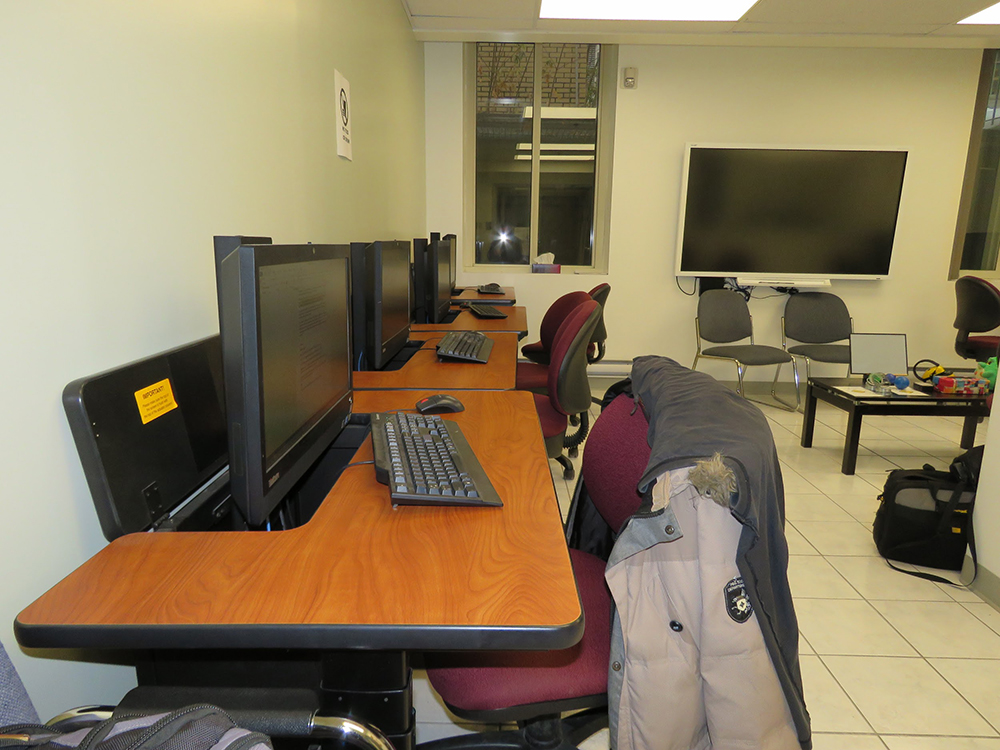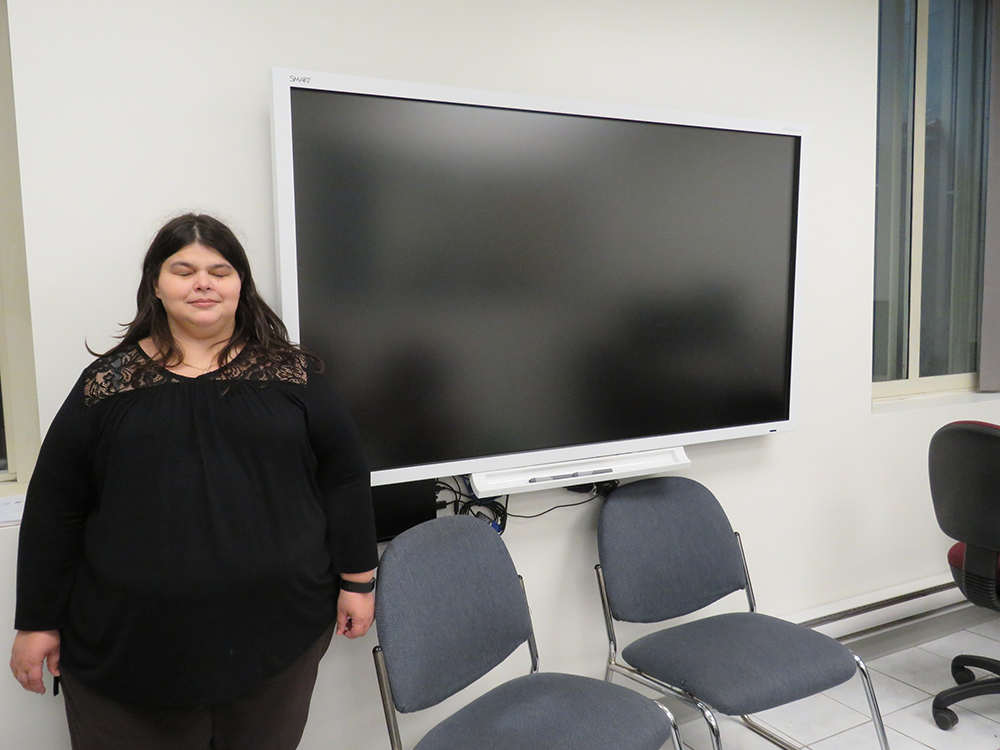Accessibility Evolves: Dawson College’s Student Inclusion Solution Assistive Technology Lab
A number of my discussions with educators across the college network in 2018 have revolved around the adoption of inclusive pedagogy (IP), Universal Design for Learning (UDL) and Assistive Technology (AT). I recently learned that Dawson College has an AT space where students with varying needs can receive the tailored support of an adapted services counsellor. My curiosity about this unique space and its mission led me to contact the college’s counsellor Rosie Arcuri as well as to speak with her predecessor Roch Ducharme, who was recently appointed the Director of CRISPESH (Centre de recherche pour l’inclusion des personnes en situation de handicap).

A view of the adaptive workstations in the Student Inclusion Solution Assistive Technology Lab and the training area (with an interactive whiteboard).
A Brief History of the Lab
“Equal opportunity without discrimination nor privilege.” These are the words inscribed next to the entrance of Rosie Arcuri’s office within the Student Inclusion Solution Assistive Technology Lab (local 2E.15). It is a space that helps to level the playing field for students with special needs. Here they can use AT and receive tailored support from a counsellor that can play a crucial role by helping students to develop strategies that will contribute to their achievement and success.
The college needed a place where all of the assistive technologies could be accessible to students. Around 2010, Dawson College, in collaboration with CRISPESH, received a one-time federal grant which allowed for the purchase of AT equipment. Dawson furnished the space for the lab, which includes a number of adaptive desks, computers, and computer software.
Initially the college staffed the lab with a technician to help students to use the technology. They realized over time that there was a deeper need to help students to develop strategies for using the technology and for organizing their workflow. This is why they decided to hire an adapted services counsellor to work with the students around 2014.
Another important change came in 2015, when the ministère de l’Éducation decided to alter its financial aid model for assistive technology (Allowance for Special Needs Program – Adult). Rather than funding the purchase of generic devices like laptops or tablets as it had in the past, the focus of the financial aid became assistive technologies. The ministry also moved from stricter financing criteria reserved for students who needed to have a major functional disability or physical impairment in order to receive funding. Now there is greater access to financial support for a variety of students with “emerging needs.”
Room Configuration
The Student Inclusion Solution Assistive Technology Lab is part of the Student AccessAbility Centre at Dawson College. It is a quiet space that is adjoined to the office for the adapted services counsellor in charge of the inclusion solution assistive technology lab (Rosie Arcuri).
In order to address a wide variety of learning needs, the lab is equipped with:
- 8 computers
- height-adjustable desks
- a SmartBoard
- a printer
- a scanner
- a number of specialized software packages
- a number of specialized devices
The installation of the SmartBoard turns the lab into a mini-classroom and allows the counsellor to train 2 to 3 students at the same time.
For those colleges that are looking to create a similar space, it is very important to conduct a needs analysis to ensure the space and assistive technologies that are chosen are facilitators rather than a hindrance to students. This important step will help to ensure that your endeavour is a successful one.
Some Assistive Technology Highlights
Roch Ducharme from CRISPESH informed me that the presence of Apple computers in the labs reflects the fact that many of the students who frequent the centre use Apple devices. In fact, Apple has made great efforts for a number of years to make their devices intuitive and accessible. Microsoft has also strived to make their products accessible, and Windows 10 has made some important improvements that increase usability for clients with impairments.
While there are a number of assistive software packages, Roch mentions that Antidote has become one of the most helpful since English language correction was introduced in version 9 of the software. Use of the software is snubbed by some purists that feel it provides too much assistance to students. However, Roch reminds teachers that Antidote is “a teaching tool, not a cheating tool,” and can be useful to anyone who composes texts.
Physically impaired students represent only about 1-2% of the clientele in the AccessAbility centre. For these students, screen-readers are an important technology, with the JAWS Screen Reader (from Freedom Scientific) being one of the most prevalent.
There are also tools to help students with dyslexia, dyspraxia and distraction, such as text-to-speech software (TTS). This software can do dynamic highlighting of text as it is being read by the software, which helps students to focus. The lab uses the product read&write from Texthelp. As the computer is reading a sentence, it highlights the phrase and the word that is being read in two different colours, which helps with focus and is an excellent assistive technology for dyslexic clients.
A video introducing some of the key features of the read&write software
Dawson College’s site licence for the read&write software allows for students to install it on their own personal device which they can use at home. For those students with recall and writing issues, the software also does word prediction for words as they are being written by students. They also have an extension that works inside the Chrome web browser.

An alternate view of the lab showing PC and Mac stations as well as the lounge area which includes a number of objects to help students manage stress, anxiety and distractions.
Teachers can help
I asked Roch and Rosie about how teachers who are interested in learning about inclusive pedagogy and assistive technologies can take their first steps in these areas.
Roch is a strong believer in Universal Design for Learning (UDL). It is important not to profile students and decide what they need. Rather, it is a good idea to provide students with some choice in how they accomplish their learning.
A good example of a change that is simple to implement is to provide access to the text of lectures to students without locking them up in a PDF document. This helps students with learning disabilities to digest the document at their own pace or to employ assistive technologies. Instead of providing a PDF, it can be preferable to provide the document in Word format. For students with low vision, they may want to make the font larger. For those who are visually-impaired, they may want to make the text as small as possible to have a faster reading rate for screen-readers like JAWS which only read one line at a time.
It is also interesting to provide multiple means of evaluation and choice in assignments. For students that have anxiety issues, forcing them to do an oral presentation in front of the class can be traumatizing. Offering the possibility to film a video or “radio assignment” might be an interesting option for these students.

Dawson College’s Adapted Services Counsellor Rosie Arcuri stands next to the SmartBoard, which can be used to train small groups of students in the lab.
Looking forward
The paradigm for AT is shifting. With more and more students taking part in the Bring Your Own Device (BYOD) technology movement, the lab is rethinking its service model for the future.
While students will continue to need a space where they can come to receive counselling, Rosie and Roch feel that the technology will need to follow the students wherever they may be. They would like for students to have access to AT through their own devices whether they are in the lab, in the classroom or at home. This key change will likely involve a virtualization project that allows remote access to technologies.
The professionals in the Student AccessAbility Centre at Dawson (of which the lab is part) are actively participating in the development of Dawson’s next strategic plan. They would ideally like to receive a new round of funding to update some of the aging technology and licenses. They are also communicating with Dawson’s UDL, active learning, and e-learning communities of practice and have been in talks with the Office of Academic Development to see how they might work more closely with new teachers. They would like to provide training on assistive technologies to teachers and professionals.
Dawson College is also looking at providing access to the space for research with a wider community of members of the disability community and the college network.
The future holds great promise for the ongoing deployment of assistive technologies and services at Dawson College.
For more information on the lab, you can visit Dawson College’s web page dedicated to the space. To learn more about CRISPESH’s partnership and mandate, please consult their website.

